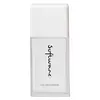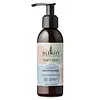What's inside
What's inside
 Key Ingredients
Key Ingredients

 Benefits
Benefits

 Concerns
Concerns

 Ingredients Side-by-side
Ingredients Side-by-side

Water
Skin ConditioningCaprylic/Capric Triglyceride
MaskingDicaprylyl Carbonate
EmollientGlyceryl Stearate Se
EmulsifyingPropanediol
SolventBenzyl Alcohol
PerfumingTocopheryl Acetate
AntioxidantHydroxyacetophenone
AntioxidantMagnesium Aluminum Silicate
AbsorbentSodium PCA
HumectantPanthenol
Skin ConditioningXanthan Gum
EmulsifyingSodium Hyaluronate
HumectantAscorbyl Glucoside
AntioxidantSodium Lauroyl Lactylate
EmulsifyingCeramide NP
Skin ConditioningPhenoxyethanol
PreservativePhytosphingosine
Skin ConditioningCeramide AP
Skin ConditioningCholesterol
EmollientEthylhexylglycerin
Skin ConditioningCarbomer
Emulsion StabilisingCeramide EOP
Skin ConditioningWater, Caprylic/Capric Triglyceride, Dicaprylyl Carbonate, Glyceryl Stearate Se, Propanediol, Benzyl Alcohol, Tocopheryl Acetate, Hydroxyacetophenone, Magnesium Aluminum Silicate, Sodium PCA, Panthenol, Xanthan Gum, Sodium Hyaluronate, Ascorbyl Glucoside, Sodium Lauroyl Lactylate, Ceramide NP, Phenoxyethanol, Phytosphingosine, Ceramide AP, Cholesterol, Ethylhexylglycerin, Carbomer, Ceramide EOP
Water
Skin ConditioningCaprylic/Capric Triglyceride
MaskingAloe Barbadensis Leaf Juice
Skin ConditioningCetyl Alcohol
EmollientGlycerin
HumectantGlyceryl Stearate
EmollientAcronychia Acidula Fruit Extract
HumectantEucalyptus Olida Leaf Extract
Skin ConditioningAlthaea Officinalis Root Extract
Skin ConditioningEpilobium Angustifolium Flower/Leaf/Stem Extract
Skin ConditioningCydonia Oblonga Leaf Extract
Skin ConditioningCamellia Sinensis Leaf Extract
AntimicrobialMoringa Oleifera Leaf Extract
Skin ConditioningSalvia Officinalis Leaf Extract
CleansingCocos Nucifera Fruit Extract
EmollientChamomilla Recutita Flower Extract
MaskingSodium Stearoyl Glutamate
CleansingXanthan Gum
EmulsifyingSodium Metabisulfite
AntioxidantPotassium Sorbate
PreservativeSodium Benzoate
MaskingPhenoxyethanol
PreservativeBenzyl Alcohol
PerfumingCitric Acid
BufferingWater, Caprylic/Capric Triglyceride, Aloe Barbadensis Leaf Juice, Cetyl Alcohol, Glycerin, Glyceryl Stearate, Acronychia Acidula Fruit Extract, Eucalyptus Olida Leaf Extract, Althaea Officinalis Root Extract, Epilobium Angustifolium Flower/Leaf/Stem Extract, Cydonia Oblonga Leaf Extract, Camellia Sinensis Leaf Extract, Moringa Oleifera Leaf Extract, Salvia Officinalis Leaf Extract, Cocos Nucifera Fruit Extract, Chamomilla Recutita Flower Extract, Sodium Stearoyl Glutamate, Xanthan Gum, Sodium Metabisulfite, Potassium Sorbate, Sodium Benzoate, Phenoxyethanol, Benzyl Alcohol, Citric Acid
 Reviews
Reviews

Ingredients Explained
These ingredients are found in both products.
Ingredients higher up in an ingredient list are typically present in a larger amount.
Benzyl Alcohol is most commonly used as a preservative. It also has a subtle, sweet smell. Small amounts of Benzyl Alcohol is not irritating and safe to use in skincare products. Most Benzyl Alcohol is derived from fruits such as apricots.
Benzyl Alcohol has both antibacterial and antioxidant properties. These properties help lengthen the shelf life of products. Benzyl Alcohol is a solvent and helps dissolve other ingredients. It can also improve the texture and spreadability.
Alcohol comes in many different forms. Different types of alcohol will have different effects on skin. This ingredient is an astringent alcohol.
Using high concentrations of these alcohols are drying on the skin. They may strip away your skin's natural oils and even damage your skin barrier. Astringent alcohols may also irritate skin.
Other types of astringent alcohols include:
According to the National Rosacea Society based in the US, you should be mindful of products with these alcohols in the top half of ingredients.
Any type of sanitizing product will have high amounts of alcohol to help kill bacteria and viruses.
Learn more about Benzyl AlcoholThis ingredient is an emollient, solvent, and texture enhancer. It is considered a skin-softener by helping the skin prevent moisture loss.
It helps thicken a product's formula and makes it easier to spread by dissolving clumping compounds.
Caprylic Triglyceride is made by combining glycerin with coconut oil, forming a clear liquid.
While there is an assumption Caprylic Triglyceride can clog pores due to it being derived from coconut oil, there is no research supporting this.
Learn more about Caprylic/Capric TriglyceridePhenoxyethanol is a preservative that has germicide, antimicrobial, and aromatic properties. Studies show that phenoxyethanol can prevent microbial growth. By itself, it has a scent that is similar to that of a rose.
It's often used in formulations along with Caprylyl Glycol to preserve the shelf life of products.
Water. It's the most common cosmetic ingredient of all. You'll usually see it at the top of ingredient lists, meaning that it makes up the largest part of the product.
So why is it so popular? Water most often acts as a solvent - this means that it helps dissolve other ingredients into the formulation.
You'll also recognize water as that liquid we all need to stay alive. If you see this, drink a glass of water. Stay hydrated!
Learn more about WaterXanthan gum is used as a stabilizer and thickener within cosmetic products. It helps give products a sticky, thick feeling - preventing them from being too runny.
On the technical side of things, xanthan gum is a polysaccharide - a combination consisting of multiple sugar molecules bonded together.
Xanthan gum is a pretty common and great ingredient. It is a natural, non-toxic, non-irritating ingredient that is also commonly used in food products.
Learn more about Xanthan Gum